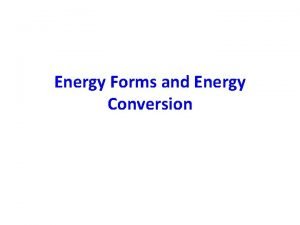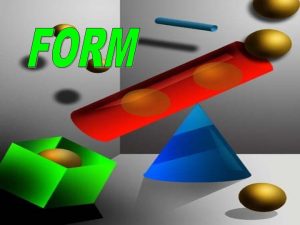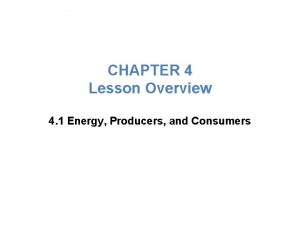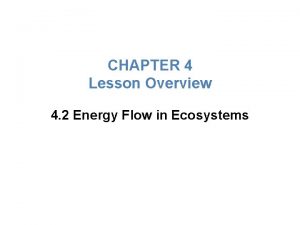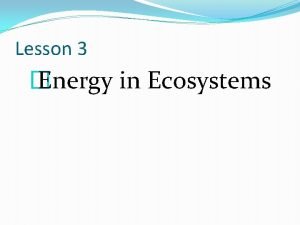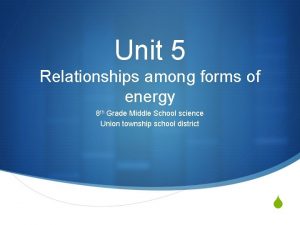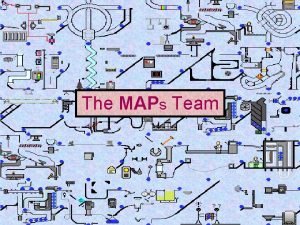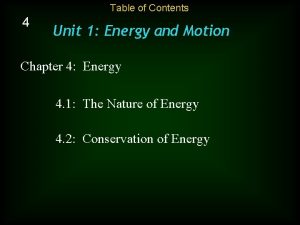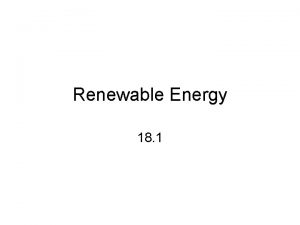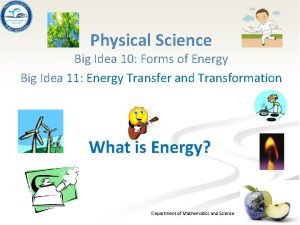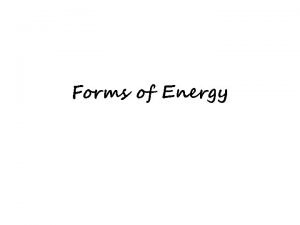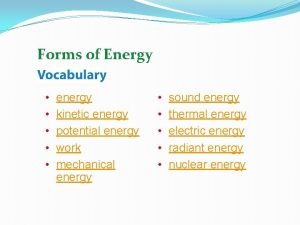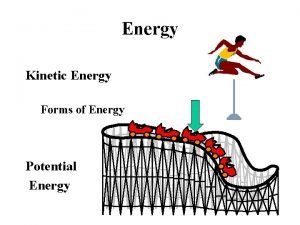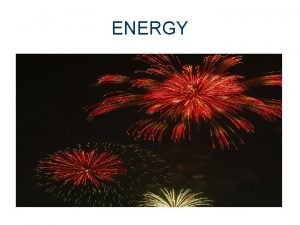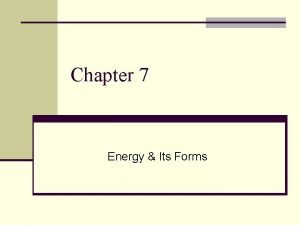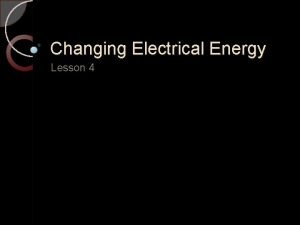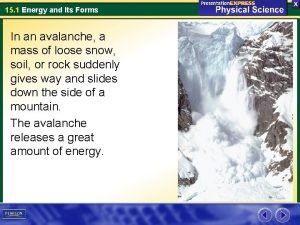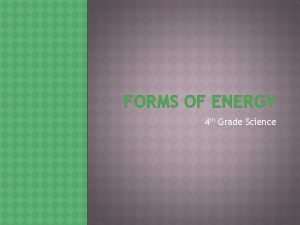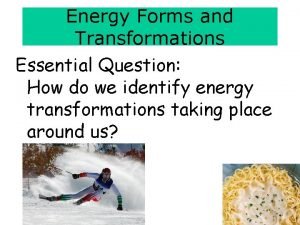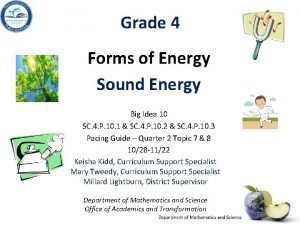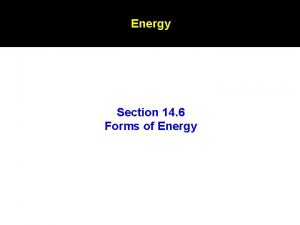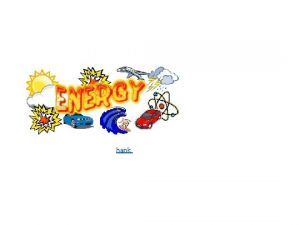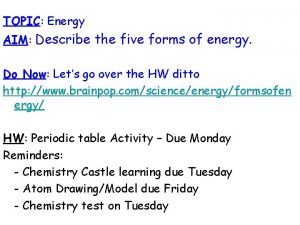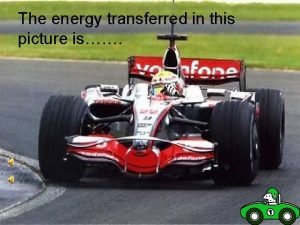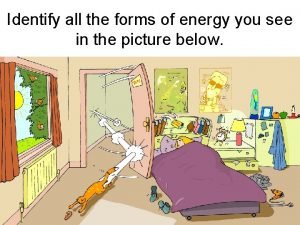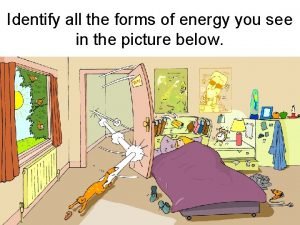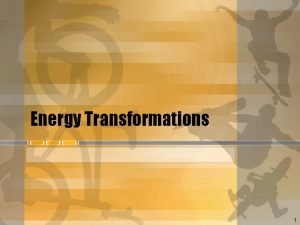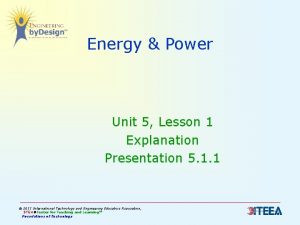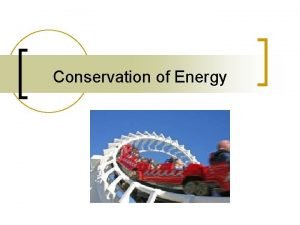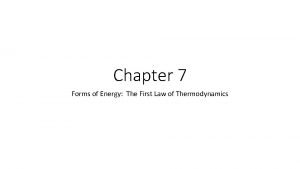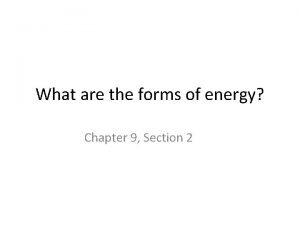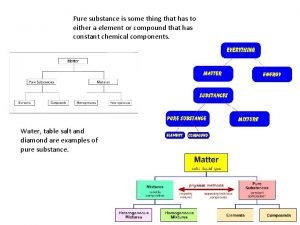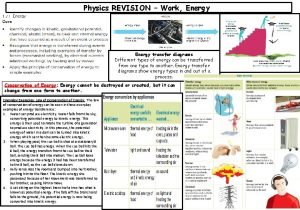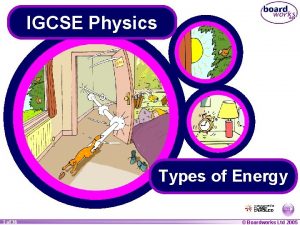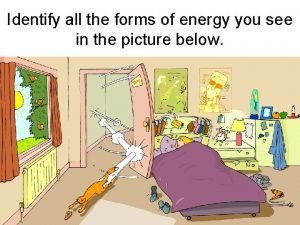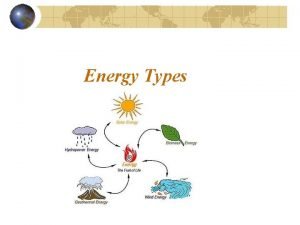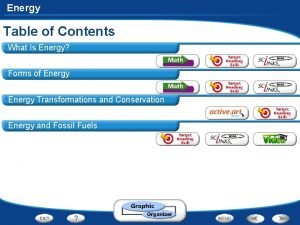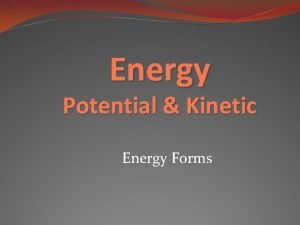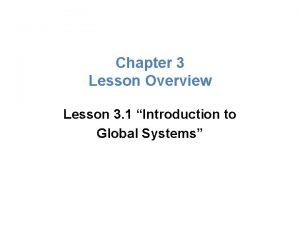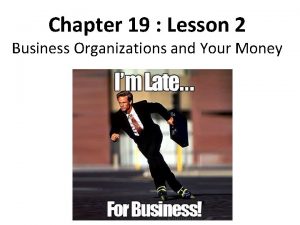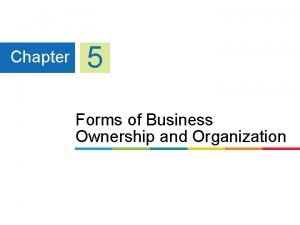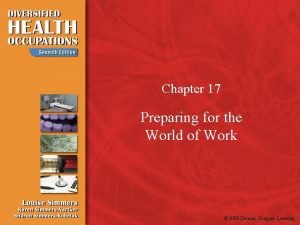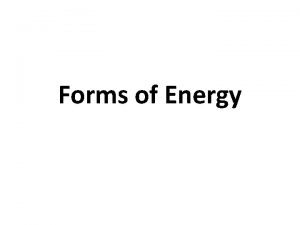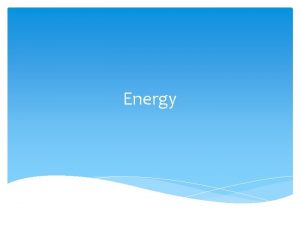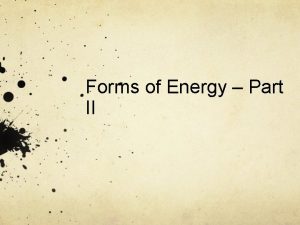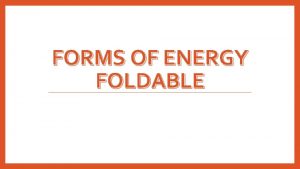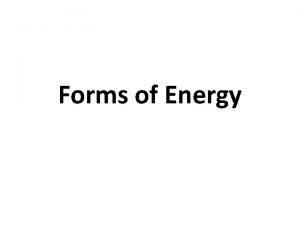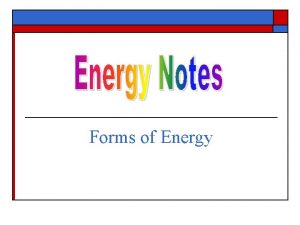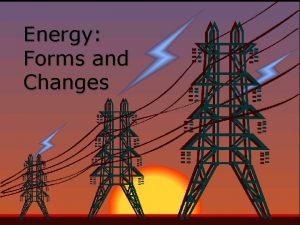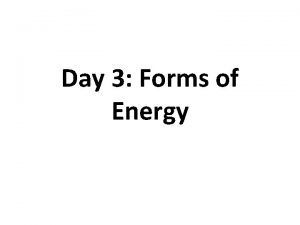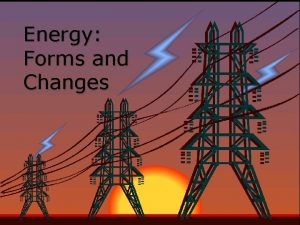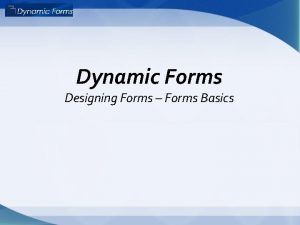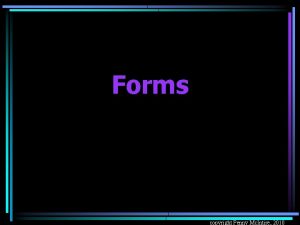Chapter Introduction Lesson 1 Forms of Energy Lesson
































































- Slides: 64

Chapter Introduction Lesson 1 Forms of Energy Lesson 2 Energy Transformations Chapter Wrap-Up

What is energy, and what are energy transformations?

What do you think? Before you begin, decide if you agree or disagree with each of these statements. As you view this presentation, see if you change your mind about any of the statements.

Do you agree or disagree? 1. A fast-moving baseball has more kinetic energy than a slow-moving baseball. 2. A large truck and a small car moving at the same speed have the same kinetic energy. 3. A book sitting on a shelf has no energy.

Do you agree or disagree? 4. Energy can change from one form to another. 5. Energy is destroyed when you apply the brakes on a moving bicycle or a moving car. 6. The Sun releases radiant energy.

Forms of Energy • What is energy? • What are potential and kinetic energy? • How is energy related to work? • What are different forms of energy?

Forms of Energy • • • energy kinetic energy potential energy work mechanical energy • • • sound energy thermal energy electric energy radiant energy nuclear energy

What is energy? • Energy is the ability to cause change. • Energy can cause changes in the motions of objects. energy from Greek energeia, means “activity”

What is energy? (cont. ) What is energy?

Kinetic Energy—Energy of Motion • Kinetic energy is energy due to motion. • All moving objects have kinetic energy. • The faster an object moves, the more kinetic energy it has. • If two objects move at the same speed, the object with more mass has more kinetic energy.

The kinetic energy (KE) of an object depends on its speed and its mass. The vertical bars show the kinetic energy of each vehicle.

Kinetic Energy—Energy of Motion (cont. ) What is kinetic energy?

Potential Energy—Stored Energy • Potential energy is stored energy due to the interactions between objects or particles. • The gravitational potential energy stored between an object and Earth depends on the object’s weight and height. • Elastic potential energy is energy stored in objects that are compressed or stretched.

Chemical potential energy is energy stored in the chemical bonds between atoms.

Potential Energy—Stored Energy (cont. ) In what way are all forms of potential energy the same?

Energy and Work • Work is the transfer of energy that occurs when a force is applied over a distance. • Work depends on both force and distance. • You only do work on an object if that object moves.

The girl does work on the box as she lifts it. The work she does transfers energy to the box. The colored bars show the work that the girl does (W) and the box’s potential energy (PE).

Energy and Work (cont. ) How is energy related to work?

All energy can be measured in joules (J).




Other Forms of Energy Describe three forms of energy.

• Energy is the ability to cause change. • The gravitational potential energy between an object and Earth increases when you lift the object. • You do work on an object when you apply a force to that object over a distance.

Which type of energy is described as the total energy of an object or group of objects due to largescale motions and interactions? A. electric energy B. mechanical energy C. radiant energy D. thermal energy

What is the transfer of energy that occurs when a force is applied over a distance? A. work B. electric energy C. kinetic energy D. potential energy

Which term refers to energy due to motion? A. kinetic energy B. potential energy C. sound energy D. stored energy

Do you agree or disagree? 1. A fast-moving baseball has more kinetic energy than a slow-moving baseball. 2. A large truck and a small car moving at the same speed have the same kinetic energy.

Do you agree or disagree? 3. A book sitting on a shelf has no energy.

Energy Transformations • What is the law of conservation of energy? • How does friction affect energy transformations? • How are different types of energy used?

Energy Transformations • law of conservation of energy • friction

Changes Between Forms of Energy The changes from one type of energy to another type of energy are called energy transformations.

A microwave oven changes electric energy into radiant energy.

Changes Between Forms of Energy (cont. ) radiant Science Use transmitted by electromagnetic waves Common Use bright and shining; glowing

Changes Between Kinetic and Potential Energy changes between kinetic energy (KE) and potential energy (PE) when a ball is thrown and moves upward and then downward.

• As the ball moves upward, its speed and kinetic energy decrease, but the potential energy is increasing because the ball’s height is increasing. • At the ball’s highest point, the gravitational potential energy is greatest, and the ball’s kinetic energy is the least.

• As the ball moves downward, potential energy decreases. At the same time, the ball’s kinetic energy increases. • When the ball reaches the player’s hand again, its kinetic energy is at the maximum value again.

The Law of Conservation of Energy According to the law of conservation of energy, energy can be transformed from one form into another or transferred from one region to another, but energy cannot be created or destroyed. What is the law of conservation of energy?

The Law of Conservation of Energy (cont. ) Friction is a force that resists the sliding of two surfaces that are touching. friction from Latin fricare, means “to rub”

Friction and the Law of Conservation of Energy • What happens to mechanical energy when you apply the bicycle brakes and the bicycle stops? • A moving bicycle has mechanical energy. When you apply the brakes, the bicycle’s mechanical energy is not destroyed.

Friction and the Law of Conservation of Energy (cont. ) • The mechanical energy is transformed into thermal energy. Friction between the brake pad and the moving wheel transforms mechanical energy into thermal energy. • There is always friction between any two surfaces that are rubbing against each other.

Using Energy • When you use energy, you usually change it from one form into another. • All forms of energy can be transformed into thermal energy. • During photosynthesis, a plant transforms the Sun’s radiant energy into chemical energy that it stores in chemical compounds.

Using Energy (cont. ) What happens to energy when it is used?

Using Energy (cont. ) • When energy changes form, some thermal energy is always released. • Scientists often refer to thermal energy that cannot be used as waste energy. • Whenever energy is used, some energy is transformed into useful energy and some is transformed into waste energy.

• Energy can change form, but according to the law of conservation of energy, energy can never be created or destroyed.

• Friction transforms mechanical energy into thermal energy. • Different forms of energy, such as sound and radiant energy, are used when someone talks on a cell phone.

All forms of energy can be transformed into what form of energy? A. electric energy B. radiant energy C. sound energy D. thermal energy

What term refers to the changes from one type of energy to another type of energy? A. friction B. potential energy C. energy transformations D. law of conservation of energy

During photosynthesis, a plant transforms the Sun’s radiant energy into what type of energy? A. chemical energy B. electric energy C. kinetic energy D. thermal energy

Do you agree or disagree? 4. Energy can change from one form to another. 5. Energy is destroyed when you apply the brakes on a moving bicycle or a moving car. 6. The Sun releases radiant energy.

Key Concept Summary Interactive Concept Map Chapter Review Standardized Test Practice

Energy is the ability to cause change. Energy transformations occur when one form of energy changes into another form of energy.

Lesson 1: Forms of Energy • Energy is the ability to cause change. • Kinetic energy is the energy a body has because it is moving. Potential energy is stored energy. • Work is the transfer of energy that occurs when a force makes an object move in the direction of the force while the force is acting on the object. • Different forms of energy include thermal energy and radiant energy.

Lesson 2: Energy Transformations • According to the law of conservation of energy, energy can be transformed from one form into another or transferred from one region to another, but energy cannot be created or destroyed. • Friction transforms mechanical energy into thermal energy. • Different types of energy are used in many ways including providing energy to move your body, to light a room, and to make and to receive cell phone calls.

Which term describes the ability to cause change? A. energy B. friction C. motion D. work

Which type of energy is due to the motion of particles that make up an object? A. thermal energy B. sound energy C. radiant energy D. kinetic energy

What is a force that resists the sliding of two surfaces that are touching? A. friction B. work C. kinetic energy D. waste energy

Most of the chemical energy used in cars ends up as what kind of energy? A. waste energy B. thermal energy C. radiant energy D. electric energy

What type of energy is stored energy due to the interactions between objects or particles? A. thermal energy B. radiant energy C. potential energy D. kinetic energy

What is another term for light energy carried by electromagnetic waves? A. electric energy B. mechanical energy C. radiant energy D. thermal energy

Work depends on what two factors? A. force and mass B. mass and distance C. force and distance D. speed and mass

Which is true according to the law of conservation of energy? A. Energy can be created and destroyed. B. Energy can be created, but not destroyed. C. Energy cannot be created or destroyed. D. Energy cannot be created, but can be destroyed.

Friction between a bicycle’s brake pads and the moving wheels transforms mechanical energy into what kind of energy? A. chemical energy B. electric energy C. potential energy D. thermal energy

Which phrase describes the energy of a ball thrown upward when the ball is at its peak? A. The ball’s kinetic energy is high. B. The ball’s kinetic energy is low. C. The ball’s potential energy is low. D. The ball’s potential energy never changes throughout the flight.
 Eroei
Eroei Energy energy transfer and general energy analysis
Energy energy transfer and general energy analysis Energy energy transfer and general energy analysis
Energy energy transfer and general energy analysis Why are related forms more agreeable than unrelated forms?
Why are related forms more agreeable than unrelated forms? Contracted form of am not
Contracted form of am not Why are related forms more agreeable than unrelated forms
Why are related forms more agreeable than unrelated forms Why are related forms more agreeable than unrelated forms?
Why are related forms more agreeable than unrelated forms? Strong forms
Strong forms Chapter 7 energy conservation of energy
Chapter 7 energy conservation of energy Chapter 4 lesson 1 energy producers and consumers
Chapter 4 lesson 1 energy producers and consumers Chapter 4 lesson 2 energy flow in ecosystems
Chapter 4 lesson 2 energy flow in ecosystems Chapter 4 lesson 2 energy flow in ecosystems answer key
Chapter 4 lesson 2 energy flow in ecosystems answer key Wind power is an indirect form of solar energy
Wind power is an indirect form of solar energy All forms of energy
All forms of energy The seven forms of energy
The seven forms of energy What are the main forms of energy
What are the main forms of energy Six forms of energy
Six forms of energy Energy transformation of washing machine
Energy transformation of washing machine Penny insulator or conductor
Penny insulator or conductor Form of energy
Form of energy Efficiency formula
Efficiency formula Mechanical energy
Mechanical energy What are the many forms of energy
What are the many forms of energy The seven forms of energy
The seven forms of energy Forms of energy include
Forms of energy include What are the main forms of energy
What are the main forms of energy Forms of energy include
Forms of energy include What are 15 forms of energy?
What are 15 forms of energy? Foldable definition
Foldable definition Forms of energy 4th grade
Forms of energy 4th grade Energy forms and transformations
Energy forms and transformations Form of energy
Form of energy Forms of energy for grade 4
Forms of energy for grade 4 6 forms of energy
6 forms of energy Nuclear energy examples
Nuclear energy examples Part 4 forms of energy continued
Part 4 forms of energy continued Five forms of energy
Five forms of energy Energy transfer of a torch
Energy transfer of a torch Light as a form of energy
Light as a form of energy Identify the energy conversions in the illustrations below
Identify the energy conversions in the illustrations below How is energy like money worksheet
How is energy like money worksheet Energy changing forms
Energy changing forms Forms of energy
Forms of energy Conservation of energy
Conservation of energy 7 forms of energy
7 forms of energy What is mechanical energy
What is mechanical energy Forms of energy
Forms of energy Sound energy
Sound energy Kinetic energy
Kinetic energy 8 types of energy
8 types of energy Electrical to mechanical example
Electrical to mechanical example Fundamental forms of energy
Fundamental forms of energy Different forms of energy
Different forms of energy Energy changes
Energy changes Forms of energy table
Forms of energy table Electricity examples
Electricity examples Forms of energy
Forms of energy Body energy conservation
Body energy conservation Chapter 3 lesson 1 introduction to global systems
Chapter 3 lesson 1 introduction to global systems S corporation definition
S corporation definition Chapter 1 lesson 1 your total health lesson 1 quiz answers
Chapter 1 lesson 1 your total health lesson 1 quiz answers Lesson 1 forms of business organizations answers
Lesson 1 forms of business organizations answers 5 forms of business ownership
5 forms of business ownership Chapter 18.2 writing a cover letter
Chapter 18.2 writing a cover letter Chapter 17:3 completing job application forms
Chapter 17:3 completing job application forms
